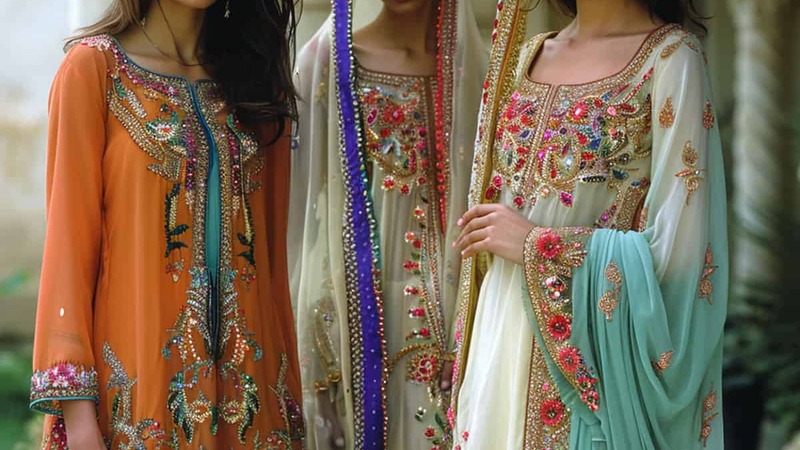The traditional dress of Pakistan is a magnificent representation of the country’s rich cultural heritage and aesthetic brilliance. Known for its vibrant colors, intricate embroidery, and luxurious fabrics, Pakistani traditional dress is not just attire but a canvas that tells stories of ancestral skill, regional histories, and deep-rooted traditions.
Each garment, whether it’s a brightly colored shalwar kameez or an elaborately embroidered lehenga, reflects a commitment to cultural preservation and artistic expression. This commitment ensures that the heritage and beauty of Pakistani traditional dress continue to influence and inspire not only within Pakistan but also on the global fashion stage, reinforcing its importance and relevance in today’s diverse world.
This article delves into the mesmerizing world of Pakistani embroidery and traditional designs, exploring their significance, types, and the craftsmanship that turns fabric into heirlooms.
Historical Significance
The history of embroidery in Pakistan dates back centuries, influenced by various dynasties that ruled the region, including the Mughals, who were known for their love of art and beauty.
Each province in Pakistan has developed its own unique style of dress and embroidery techniques, influenced by local customs, climate, and historical exchanges with neighboring regions. These garments are more than just clothing; they are a pride of heritage, showcased particularly during festivals, weddings, and cultural ceremonies.
Types of Traditional Pakistani Dresses
- Shalwar Kameez: The most common traditional outfit, worn by both men and women, consists of a long shirt (kameez) and a pair of trousers (shalwar). The female version is often paired with a dupatta (scarf), which adds grace and modesty to the ensemble.
- Lehenga Choli: Typically worn by women in weddings and formal occasions, this outfit includes a long skirt (lehenga), a short blouse (choli), and a dupatta. The lehenga choli is celebrated for its grandeur and is usually heavily embroidered.
- Sherwani: A formal garment worn by men, especially at weddings. It is a long coat buttoned to the neck with the length usually extending just below the knee, richly decorated with embroidery and paired often with a turban.
Embroidery Techniques
Pakistani embroidery is a craft perfected by generations of artisans, each region adding its unique touch and technique to the practice.
- Zardozi: An ancient form of embroidery that uses gold and silver threads to create majestic, royal patterns. It was once used to embellish the attire of the royalty and is now popular in bridal wear.
- Mirror Work: Known locally as ‘Shisha,’ this technique incorporates small mirrors that are sewn into the fabric with colorful threads. It is particularly popular in Sindh and Balochistan provinces.
- Phulkari: Originating from Punjab, ‘Phulkari’ literally means ‘flower work,’ which is reflected in the brightly colored silk threads embroidered in beautiful floral patterns on shawls and dupattas.
- Chikankari: Though it traces its origins to Lucknow, India, Chikankari is highly popular in Pakistan as well. This technique involves delicate hand embroidery with white thread on cool, pastel shades of light fabrics.
- Kashidakari: From the northern regions, particularly Kashmir, this embroidery is known for its intricate designs of nature, including flowers, leaves, and birds, using fine silk threads.
Materials and Fabrics
The choice of fabric plays a crucial role in Pakistani traditional dress, with each material selected to complement the type of embroidery and the occasion it is meant for. Commonly used fabrics include:
- Cotton: Widely used for everyday wear because of its comfort and ease.
- Silk: Preferred for formal garments due to its luxurious feel and aesthetic appeal.
- Chiffon and Georgette: Popular choices for feminine bridal wear, allowing for flowy designs.
- Velvet: Often used in royal and bridal wear, especially in winter weddings, providing a rich texture for heavy embroidery.
Colors and Patterns
The traditional Pakistani palette is bold and vibrant, reflecting the lively culture and spirit of its people. Reds, greens, blues, and golds dominate wedding attire and festival wear, symbolizing joy and prosperity. The patterns often comprise floral and geometric motifs, each carrying specific cultural meanings and often telling stories of the regions they originate from.
Contemporary Influences
While traditional Pakistani dress remains popular, contemporary designers have embraced these classic elements, blending them with modern aesthetics to appeal to today’s global audience. Designers like HSY, Maria B., and Sana Safinaz are at the forefront of this movement, introducing cuts and styles that maintain traditional elegance while meeting modern fashion demands.
Conclusion
The traditional dress of Pakistan showcases a rich tapestry of history, culture, and artistry. From the rural artisan embroidering a shalwar kameez with phulkari motifs to the haute couture designer crafting a bridal lehenga in a Karachi studio, each thread woven into the fabric of Pakistani dress carries the legacy of age-old traditions. As these garments traverse global stages, they not only tell the story of Pakistan’s cultural richness but also of a craft that has grown and evolved while staying true to its roots.
